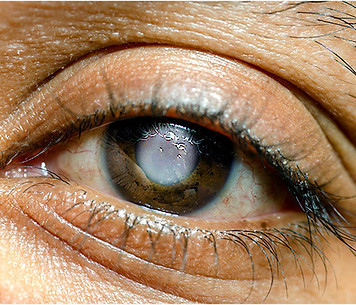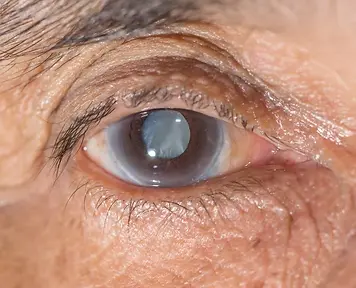
OPTOMETRIC CONDITIONS

Dry Eyes
Dry eye is a syndrome that occurs when your tears dry up too fast or your eyes don’t make enough tears to stay wet. As a result, eyes may feel scratchy, stinging or burning, and there may be redness, sensitivity to light or blurred vision. Dry eyes can have a signficant impact on quality of life, but fortunately, there are a wide range of treatment options. Warm compresses, eyelid scrubs, omega-3 supplements, blinking exercises, drinking more water, using a humidifier and medicated eyedrops or ointments can help reduce symptoms.
For more severe or persistent cases of dry eyes, Lumecca-I, Forma-I, meibomian gland expression and punctal plugs can be used to effectively improve symptoms. Dry eye is often not diagnosed correctly because the symptoms are similar to other conditions. It is recommended that you make an appointment with one of our specialists to confirm the diagnosis and determine the most effective treatment plan.

Puffy Undereyes
Periorbital edema, more commonly known as puffy undereyes, refers to an accumulation of fluid in the tissues surrounding the eyes, resulting in a swollen or puffy appearance around and under the eye. While puffy undereyes are usually benign, they can be aesthetically bothersome.
Treatment for periorbital edema depends on the underlying cause. Lifestyle changes such as reducing salt, increasing hydration, improving sleep, and managing allergies can help alleviate mild cases. In cases where swelling is severe or persistent, Lumecca-I, Forma-I, Morpheus8, or some combination of these, can be used to effectively improve puffiness. It is recommended that you make an appointment with one of our specialists to determine the most effective treatment plan.

Dark Undereyes
Periorbital hyperpigmentation, commonly known as dark undereyes, refers to the darkening of the skin around the eyes, which creates a shadowed or discoloured appearance. Hyperpigmentation in this area can vary in intensity, from mild to severe, and may appear as brown, blue, or even purple hues.
There are several factors that contribute to dark undereyes, including genetics, melanin production, thinning skin, rubbing the eyes, lack of sleep, sun exposure, and certain medical conditions. Lifestyle changes, like improving sleep and avoiding allergens, as well as topical treatments containing ingredients like vitamin C, retinoids, kojic acid, or hydroquinone, can help lighten pigmentation, but Lumecca-I, Forma-I and Morpheus8 are the most effective way to reduce the appearance of dark undereyes. It is recommended that you make an appointment with one of our specialists to determine the most effective treatment plan.

Ptosis (Droopy Eyelid)
Ptosis refers to a drooping or sagging of the upper eyelid, which can partially or completely obstruct the pupil and affect one or both eyes. This condition occurs due to weakening or damage to the muscles that are responsible for lifting the eyelid. There are various causes of ptosis, including age-related weakening of the facial muscle, congenital factors present from birth, neurological conditions, trauma, or underlying health issues.
Treatment for ptosis depends on its underlying cause and severity, but Forma-I or Morpheus8, can be used to effectively tighten skin and lift eyelids. It is recommended that you make an appointment with one of our specialists to determine the most effective treatment plan.
.png)
Chalazion
A chalazion is a bump or swelling on the eyelid that occurs when one of the meibomian glands becomes blocked, resulting in inflammation. (This condition is different from a stye, which is an infection of the glands.) As a chalazion progresses, it can become larger, firmer, and may cause mild irritation or blurred vision. Though chalazion often resolve on their own within a few weeks to a couple of months, they can sometimes persist and require medical attention.
Warm compresses and gentle massage can be used to manage symptoms, but Lumecca-I is the most effective treatment for a chalazion. It is recommended that you make an appointment with one of our specialists to confirm the diagnosis and determine the most effective treatment plan.

Eye Twitching
An eye twitch is an involuntary spasm of the muscles around the eyes, Eye twitches usually occur as a result of stress, fatigue, eye strain, dry eyes, and certain medications. More frequent eye twitching is often a hereditary condition that can be classified into two categories: eyelid myokymia or blepharospasm.
Treatment for eye twitching depends on the underlying cause. Lifestyle changes such as reducing stress, increasing hydration, improving sleep, and limiting caffeine and alcohol can help alleviate mild cases. is recommended that you make an appointment with one of our specialists to determine the most effective treatment plan.

Myopia
Myopia (often referred to as nearsightedness) is a common eye condition that causes closer objects to appear sharp and clear, and distant objects to appear blurry. There is currently no known cure for myopia, but there are treatment options to help prevent this condition from worsening and becoming progressive.
Myopia has become more common in children, but we are committed to slowing the progression of this condition through Myopia Management Services that are personalized for each patient. In particular, we recommend Hoya MiYOSMART Optical Lenses, which are a spectacle lens that has been shown to slow the progression of myopia in children. It is recommended that you make an appointment with one of our specialists to confirm the diagnosis and determine the most effective treatment plan for your child.

Misalignment
If you are struggling with eye strain, neck pain, headaches, dizziness, dry eye, blurry vision, light sensitivity or motion sickness, it could be caused by eye misalignment. An eye misalignment is a condition where the eyes do not align with each other when looking at an object—while one eye looks directly at the object, the other eye may turn inward (esotropia), outward (exotropia), upward (hypertropia), or downward (hypotropia). As a result, the eyes struggle to maintain focus on near objects, which can cause uncomfortable symptoms.
Brantford Optometry uses Neurolens, which is an innovative, immersive diagnostic system that provides immediate results, so we can take steps to improve your symptoms quicker than ever. Neurolens assessments are free for current patients, but you don’t need to be a patient at Brantford Optometry to schedule an assessment.

Glaucoma
Glaucoma is a group of eye conditions that cause damage to the optic nerve, often due to elevated pressure inside the eye. This damage is progressive and, if left untreated, can lead to permanent vision loss. In its early stages, glaucoma typically has no noticeable symptoms—which is why it’s often called the “silent thief of sight.” Regular eye exams are essential for early detection.
If you have a family history of glaucoma or are experiencing vision changes, we recommend booking an eye exam to assess your risk and determine the best course of care. While there is no cure for glaucoma, treatment can effectively manage the condition and prevent further vision loss. Options may include prescription eye drops, oral medications, laser therapy or surgical procedures, depending on the type and severity of the condition.
.jpg)
Cataracts
A cataract is a clouding of the eye’s natural lens, which can cause blurry vision, dull colour perception, and increased sensitivity to light. Cataracts develop gradually, often as a part of the natural aging process, but they can also be caused by injury, certain medications, or underlying health conditions like diabetes.
In the early stages, symptoms may be managed with updated prescriptions and brighter lighting. However, as the cataract progresses and begins to interfere with daily activities, surgical intervention is the only effective treatment. If you have noticed changes in your vision, we recommend scheduling an eye exam to determine whether a cataract may be the cause and to discuss treatment options.

Macular Degeneration
Macular degeneration is a progressive eye condition that affects the macula, which is the part of the retina responsible for sharp, central vision. It’s most common in older adults and is a leading cause of vision loss in people over 60. Early signs may include blurred or distorted central vision, difficulty reading, or trouble recognizing faces.
While there is no cure, early detection is key. Depending on the type and severity, treatment options may include nutritional supplements, lifestyle changes, or specialized injections to slow progression and preserve vision. If you’re experiencing changes in your central vision or have a family history of macular degeneration, we recommend booking an eye exam to assess your risk and explore treatment options.

Diabetic Retinopathy
Diabetic retinopathy is a complication of diabetes that affects the blood vessels in the retina, which is the light-sensitive tissue at the back of the eye. Over time, high blood sugar levels can damage these vessels, leading to vision changes and, in severe cases, permanent vision loss.
In its early stages, diabetic retinopathy often has no noticeable symptoms, which makes regular eye exams essential for anyone with diabetes. As the condition progresses, patients may experience blurred vision, dark spots, or difficulty seeing at night. If you have diabetes—even if your vision seems fine—we recommend scheduling an eye exam to monitor your retinal health and catch any changes early.


